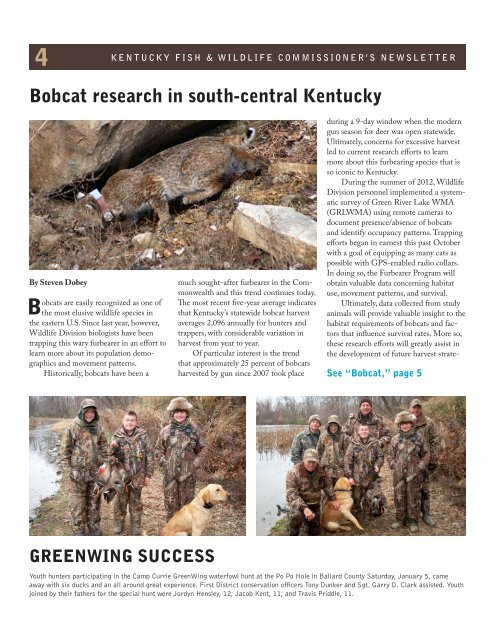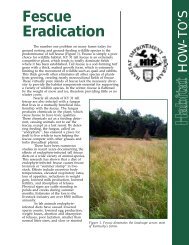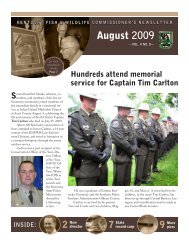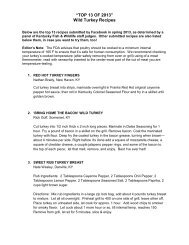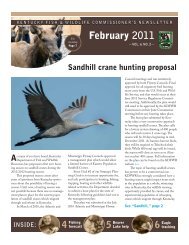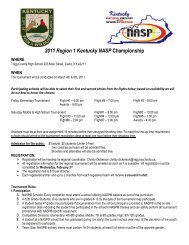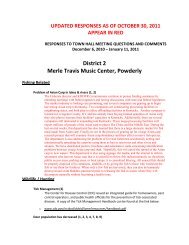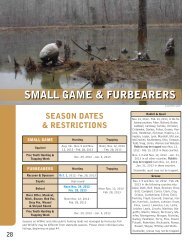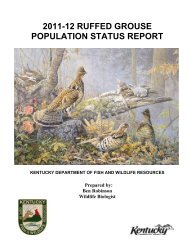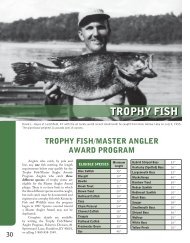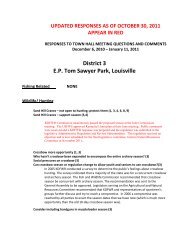January 2013 Newsletter - Kentucky Department of Fish and Wildlife ...
January 2013 Newsletter - Kentucky Department of Fish and Wildlife ...
January 2013 Newsletter - Kentucky Department of Fish and Wildlife ...
You also want an ePaper? Increase the reach of your titles
YUMPU automatically turns print PDFs into web optimized ePapers that Google loves.
4<br />
KENTUCKY FISH & WILDLIFE COMMISSIONER’S NEWSLETTER<br />
Bobcat research in south-central <strong>Kentucky</strong><br />
By Steven Dobey<br />
Bobcats are easily recognized as one <strong>of</strong><br />
the most elusive wildlife species in<br />
the eastern U.S. Since last year, however,<br />
<strong>Wildlife</strong> Division biologists have been<br />
trapping this wary furbearer in an effort to<br />
learn more about its population demographics<br />
<strong>and</strong> movement patterns.<br />
Historically, bobcats have been a<br />
much sought-after furbearer in the Commonwealth<br />
<strong>and</strong> this trend continues today.<br />
The most recent five-year average indicates<br />
that <strong>Kentucky</strong>’s statewide bobcat harvest<br />
averages 2,096 annually for hunters <strong>and</strong><br />
trappers, with considerable variation in<br />
harvest from year to year.<br />
Of particular interest is the trend<br />
that approximately 25 percent <strong>of</strong> bobcats<br />
harvested by gun since 2007 took place<br />
during a 9-day window when the modern<br />
gun season for deer was open statewide.<br />
Ultimately, concerns for excessive harvest<br />
led to current research efforts to learn<br />
more about this furbearing species that is<br />
so iconic to <strong>Kentucky</strong>.<br />
During the summer <strong>of</strong> 2012, <strong>Wildlife</strong><br />
Division personnel implemented a systematic<br />
survey <strong>of</strong> Green River Lake WMA<br />
(GRLWMA) using remote cameras to<br />
document presence/absence <strong>of</strong> bobcats<br />
<strong>and</strong> identify occupancy patterns. Trapping<br />
efforts began in earnest this past October<br />
with a goal <strong>of</strong> equipping as many cats as<br />
possible with GPS-enabled radio collars.<br />
In doing so, the Furbearer Program will<br />
obtain valuable data concerning habitat<br />
use, movement patterns, <strong>and</strong> survival.<br />
Ultimately, data collected from study<br />
animals will provide valuable insight to the<br />
habitat requirements <strong>of</strong> bobcats <strong>and</strong> factors<br />
that influence survival rates. More so,<br />
these research efforts will greatly assist in<br />
the development <strong>of</strong> future harvest strate-<br />
See “Bobcat,” page 5<br />
GREENWING SUCCESS<br />
Youth hunters participating in the Camp Currie GreenWing waterfowl hunt at the Po Po Hole in Ballard County Saturday, <strong>January</strong> 5, came<br />
away with six ducks <strong>and</strong> an all around great experience. First District conservation <strong>of</strong>ficers Tony Dunker <strong>and</strong> Sgt. Garry D. Clark assisted. Youth<br />
joined by their fathers for the special hunt were Jordyn Hensley, 12; Jacob Kent, 11; <strong>and</strong> Travis Priddle, 11.


